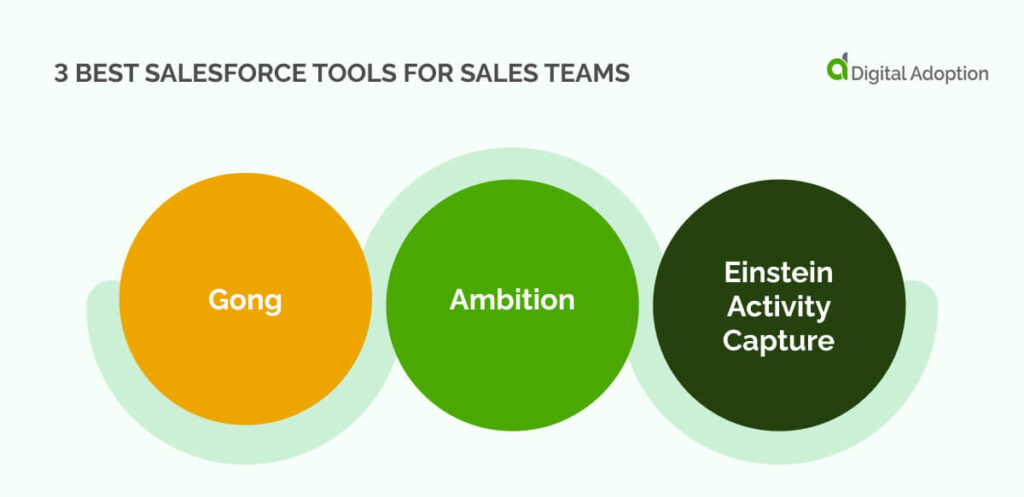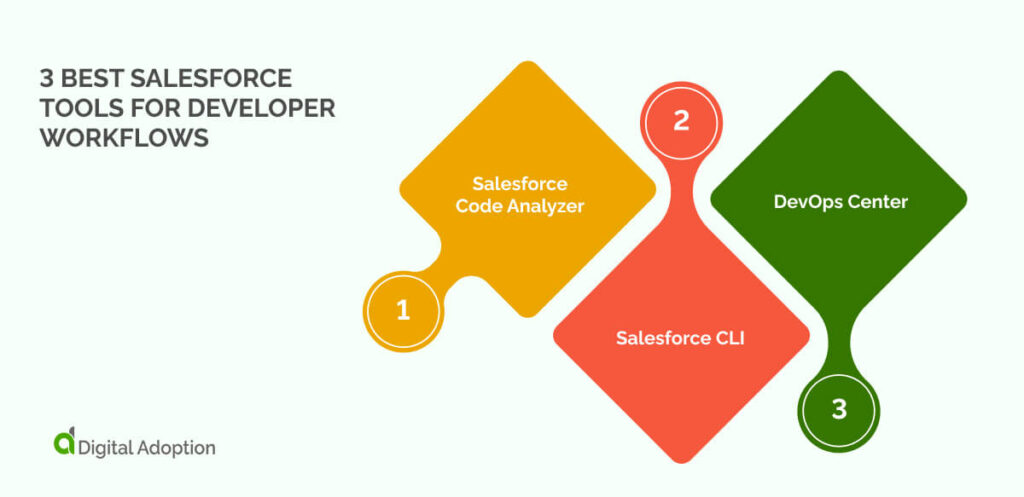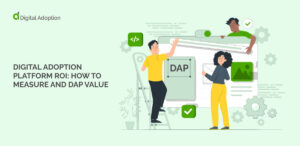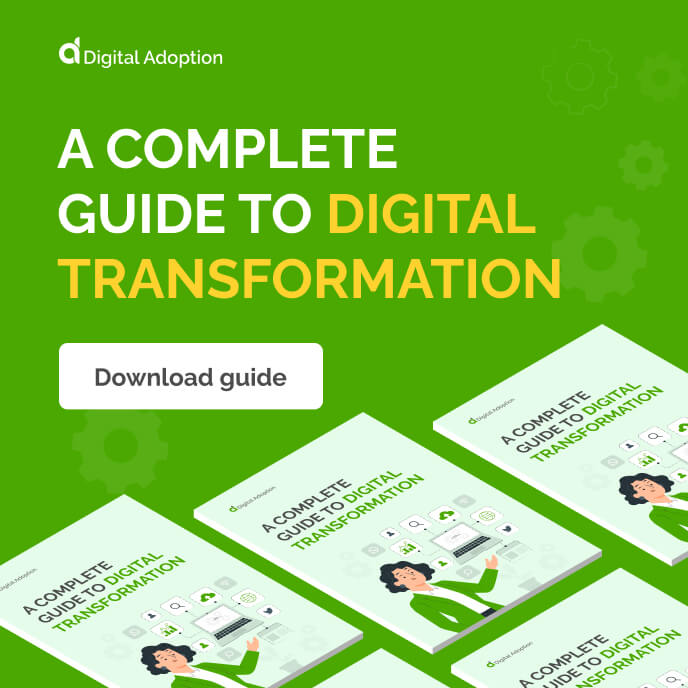Salesforce offers a wide ecosystem of digital tools and third-party integrations, which can feel overwhelming to navigate.
With numerous tools available across various clouds and use cases, it can be challenging for teams to determine which ones best support their specific workflows.
We break down the top Salesforce tools by function, covering sales, marketing, customer service, developer, and analyst needs.
Take a look at the options below to find out which ones may unlock better performance for your team.
3 Best Salesforce tools for sales teams

Sales professionals often work with records that are missing key information. Without accurate updates, it becomes harder to understand how deals progress. Managers struggle to step in at the right time or spot delays early.
The tools below bring more order to daily activity by linking conversations to opportunity records and highlighting where progress stalls.
| Tool | Type | Key Features |
| Gong | Third-party tool (AppExchange) | Conversation intelligence, call analysis, deal insights |
| Ambition | Third-party tool (AppExchange) | Performance scorecards, gamification dashboards, coaching tools |
| Einstein Activity Capture | Salesforce-native tool | Email syncing, calendar integration, activity dashboards |
Gong
- Type: Third-party tool listed on AppExchange
- Key features: Conversation intelligence, call analysis, deal insights
Gong captures and analyzes sales conversations so teams can take action more quickly. The platform prevents the need for manual note-taking and instead captures key data points which can be used in evaluation.
Managers can find out what sales representatives are asking and what their talk-to-listen ratio is without listening in live. They can also compile the best conversations into a playbook to help train future employees.
Ambition
- Type: Third-party tool listed on AppExchange
- Key features: Performance scorecards, gamification dashboards, coaching tools
Ambition tracks representative activity in Salesforce. It gives managers tools for performance management and focused coaching. Instead of siloed data, employees can access meaningful insights so they can make data-driven decisions.
Tapping into sales teams’ love of competing, the tool also has gamification features such as leaderboards and contests to help with boosting engagement and performance.
Einstein Activity Capture
- Type: Salesforce-native tool
- Key features: Email syncing, calendar integration, activity dashboards
Einstein Activity Capture logs emails and calendar events into Salesforce automatically to keep records up to date.
Sales teams no longer have to handle fragmented data across multiple systems, instead benefiting from a cohesive view of all interactions in one centralized system. They can ensure all sales interactions are tracked and follow up with leads more thoroughly, avoiding the need for manual data entry.
3 Best Salesforce tools for marketing teams
Marketing teams often lose visibility once contacts move into Salesforce. Incomplete records disrupt attribution. Teams also struggle to adjust outreach when they cannot connect behavior to campaign activity.
When campaign tools link directly to Salesforce, teams can act on signals as they happen thanks to seamless technology integration. Leads remain connected to their original context, allowing outreach to follow recent engagement rather than stale data.
| Tool | Type | Key Features |
| Pardot | Third-party tool (AppExchange) | Email automation, lead scoring, ROI reporting |
| Drift | Third-party tool (AppExchange) | Live chat, chatbot routing, CRM syncing |
| Journey Builder | Salesforce-native tool | Journey orchestration, multi-channel campaigns, personalization triggers |
Pardot
- Type: Third-party tool listed on AppExchange
- Key features: Email automation, lead scoring, ROI reporting
Pardot automates email campaigns and scores leads so that sales teams can prioritize outreach and close deals more quickly. It provides tools such as lead capture forms and landing pages so that employees can attract and capture leads.
With automated workflows, they can guide those leads through the buying journey and view engagement with in-built scoring systems. They can then iterate on marketing campaigns, informed by data. As Pardot integrates with Salesforce, it becomes much easier to pass leads on to sales teams.
Drift
- Type: Third-party tool listed on AppExchange
- Key features: Live chat, chatbot routing, CRM syncing
Drift uses chatbots and live chat to connect visitors with representatives and pass leads into
Salesforce. It turns websites into an active lead generation tool, automating conversation so that human employees do not need to be available 24/7 to nurture site visitors.
Drift helps to identify qualified leads by speaking with them and gaining an understanding of their needs and interests. Sales teams can then access conversation history and follow up with qualified leads.
Journey Builder
- Type: Salesforce-native tool
- Key features: Journey orchestration, multi-channel campaigns, personalization triggers
Journey Builder automates customer campaigns using behavioral triggers and Salesforce data. It lets marketers design action sequences across multiple channels, which unlocks both personalized and automated experiences for customers.
It allows for personalized content which is tailored to variables such as customer demographics and previous interactions, freeing up marketers’ time for strategic planning and analysis.
3 Best Salesforce tools for customer service
Service agents often shift between tools to find case information, which introduces delays and raises the risk of error. Without a central source of truth, agents may overlook recent actions or repeat steps already taken due to gaps in organizational structure.
Connecting service platforms to Salesforce gives agents immediate access to conversation history and case progress. They complete updates in one place, without depending on memory or manual reconciliation.
| Tool | Type | Key Features |
| Five9 | Third-party tool (AppExchange) | Cloud contact center, call routing, service analytics |
| Slack + Salesforce | Salesforce-acquired product | CRM alerts, workflow triggers, thread collaboration |
| Macros | Salesforce-native tool | Action automation, template support, case updates |
Five9
- Type: Third-party tool listed on AppExchange
- Key features: Cloud contact center, call routing, service analytics
Five9 connects cloud telephony to Salesforce so agents can handle calls efficiently and resolve cases faster. They benefit from access to real-time data and intelligence powered by AI, directly within the Salesforce environment.
As workers can view insights into customer interactions, they can make informed decisions about next steps and ensure interactions are personalized. Features such as predictive analytics and sentiment analysis also help agents to understand customer needs and improve their service.
Slack + Salesforce
- Type: Salesforce-acquired product
- Key features: CRM alerts, workflow triggers, thread collaboration
Slack + Salesforce work together, providing employees with Salesforce data and tools directly within the Slack environment. They no longer have to leave the interface and work across multiple systems, as they can collaborate and access Salesforce information from the messaging platform.
Teams can categorize channels by team, project or topic, and automate workflows based on data. AI-powered features allow teams to find and share relevant Salesforce information with ease.
Macros
- Type: Salesforce-native tool
- Key features: Action automation, template support, case updates
Macros let agents complete common tasks in Salesforce using predefined templates and updates. They are a powerful automation tool and allow employees to perform multiple actions in a fraction of the time.
Not only does the functionality streamline workflows and improve productivity, it also ensures that tasks are performed consistently. Teams benefit from fewer errors and higher data quality.
3 Best Salesforce tools for developer workflows

Development teams face challenges when tracking changes across environments. Unclear version histories and inconsistent deployment practices make it harder to understand what caused a fault. Manual processes often lead to mismatched configurations.
Tools that offer command-line access and environment control give developers a more reliable way to manage releases. Developers work from verified data rather than second-guessing the origin of an issue.
| Tool | Type | Key Features |
| Salesforce Code Analyzer | Salesforce-native tool | Code scanning, security rules, CLI integration |
| Salesforce CLI | Salesforce-native tool | Metadata management, testing automation, organization control |
| DevOps Center | Salesforce-native tool | Change tracking, GitHub sync, visual deployments |
Salesforce Code Analyzer
- Type: Salesforce-native tool
- Key features: Code scanning, security rules, CLI integration
Salesforce Code Analyzer identifies issues in Apex and Lightning code to maintain performance and security standards. As developers can catch potential issues early, they can ensure applications are more robust and secure.
It can examine code without running it, and flag problems before they become expensive fixes later in the development cycle. Not only does the tool help to avoid issues, it helps developers to improve their code quality and avoid deviations from Salesforce best practices.
Salesforce CLI
- Type: Salesforce-native tool
- Key features: Metadata management, testing automation, organization control
Salesforce CLI gives developers command-line control to deploy changes and automate Salesforce environment setup. The free and open-source tool helps employees to speed up development and deployment processes. It makes use of plugins to extend available functions, which can include deploying code and managing users.
DevOps Center
- Type: Salesforce-native tool
- Key features: Change tracking, GitHub sync, visual deployments
DevOps Center manages version control and releases using native pipelines inside Salesforce. It automatically tracks changes and provides a source control repository for project changes, so that everyone works with consistent metadata.
The tool also has productivity features such as conflict management, which identifies items that would conflict with others in the pipeline, and activity history to improve visibility and error tracking.
3 Best Salesforce tools for admins & analysts
Administrators and analysts often field urgent requests to explain shifts in performance. Standard dashboards offer limited flexibility when reviewing complex relationships between records.
Rather than scanning exports for missing context, teams can use analytical tools to explore data flows within Salesforce and provide targeted responses backed by live system activity.
| Tool | Type | Key Features |
| Tableau | Third-party tool (AppExchange) | Visual dashboards, data connectors, forecast tools |
| Salesforce Chatter | Salesforce-native tool | Record feeds, file sharing, team mentions |
| CRM Analytics | Salesforce-native tool | Analytics apps, predictive insights, embedded dashboards |
Tableau
- Type: Third-party tool listed on AppExchange
- Key features: Visual dashboards, data connectors, forecast tools
Tableau visualizes Salesforce data to help teams explore trends and make informed decisions. Users can create interactive dashboards and reports, pulling from a wide range of data sources. Analysts no longer need to work across multiple data sources, such as spreadsheets and cloud sources.
Instead, they can work directly within Salesforce to create and share impactful visualizations with the wider team.
Salesforce Chatter
- Type: Salesforce-native tool
- Key features: Record feeds, file sharing, team mentions
Salesforce Chatter lets employees share information and collaborate on projects, making it easier to maintain context and knowledge retention across teams. Included at no extra cost for all Salesforce users, it integrates with records within the platform so that employees can view context-specific communication.
There are also analytics and reporting tools to help with tracking user activity and engagement.
CRM Analytics
- Type: Salesforce-native tool
- Key features: Analytics apps, predictive insights, embedded dashboards
CRM Analytics provides embedded dashboards and AI-driven suggestions directly in Salesforce. It helps teams to understand and analyze their data, improving decision-making. Customer-facing teams benefit from intelligent insights and predictions, along with recommendations to improve performance.
In summary
Salesforce can feel like a complete solution in the first few weeks and months, but many teams eventually run into blockers. Pain points such as reporting across systems or triggering actions based on live data can slow down workflows.
Fortunately, the above information should provide clarity on a few tools which can speed up day-to-day processes and make life easier. By comparing the tools above, you can begin considering options to elevate your out-of-the-box solution and align tools with a broader digital strategy.
People Also Ask
-
What are Salesforce tools?Salesforce tools are features or add-ons that change how users interact with data and complete tasks inside the platform. Some are built by Salesforce. Others are developed externally and made available through the AppExchange.
-
How do I choose the right Salesforce tools?Start by looking at what slows your team down. The best tool is the one that removes that friction without creating new problems elsewhere. Check how it connects with your existing setup and whether it solves the issue in a lasting way.









